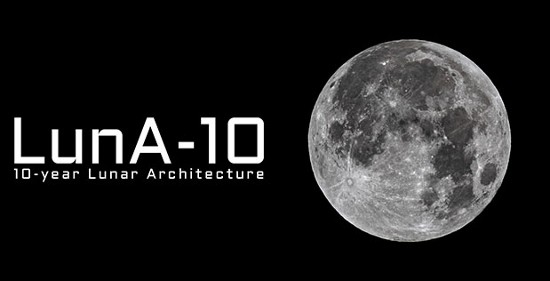The Defence Advanced Research Projects Agency (DARPA) has selected 14 companies to build a human presence on the Moon and support infrastructure. DARPA has set 2035 as the deadline for achieving the means to support a permanent human presence on the lunar surface.
The 14 companies chosen for the LunA-10 project are tasked with the design and development of solutions to address power requirements and delivery, resource utilization, communications, navigation, transportation, logistics, construction and robotics.
DARPA is working within the framework of NASA’s Artemis Accords. The model that NASA has cultivated includes using trusted industry partners with the task of creating the lunar technologies and capabilities necessary for a permanent presence on the Moon’s surface and surrounds. Future astronauts, scientists, engineers and others who go to the Moon will find a self-sustaining lunar infrastructure. The DARPA plan intends to foster competing solutions to achieve the same results, a planned redundancy.
The South Pole is the best place to establish a permanent lunar presence. A waystation in permanent cislunar orbit will serve to support the activity on the Moon. A communication and power delivery system will connect those on the Moon’s surface, in cislunar orbit, and back here on Earth.
The companies selected include Blue Origin, CisLunar Industries, Crescent Space Services LLC, Fibertek, Inc., Firefly Aerospace, GITAI, Helios, Honeybee Robotics, ICON, Nokia of America, Northrop Grumman, Redwire Corporation, Sierra Space and SpaceX. Some of these companies are familiar names. Others less so.
Michael Nayak, Program Manager for DARPA’s Strategic Technology Office, in a press release, describes the LunA-10 aim “to facilitate the fusing and co-optimization of as many infrastructure sectors as possible, into key nodes that can be scaled up in the future…Imagine a wireless power station that can also provide comms and navigation in its beam…to support a thriving commercial economy on the Moon.”
The named companies will work together to combine their expertise and provide a statement of progress in a meeting planned for April 2024. This will be followed by a report to be delivered in June 2024.
Several lesser-known companies chosen for LunA-10 will be providing critical components for the development of a permanent human presence on and around the Moon. Here are some of the companies selected that may be less familiar to you and the expertise they are bringing to the development of a comprehensive lunar infrastructure.
- CisLunar Industries‘ CEO, Gary Calnan noted “DARPA finally did what the industry was waiting for…bringing together 14 companies representing complementary parts of the future lunar economy…where the entire space domain can participate.” CisLunar will use its knowledge to develop METAL (Material Extraction, Treatment, Assembly and Logistics), a framework for providing in-situ material resources and robotics to build lunar infrastructure.
- Crescent Space Services LLC, a new company created by Lockheed Martin will provide infrastructure-as-a-service to support lunar missions. States CEO, Joe Landon, the company “is well positioned to serve the upcoming wave of lunar science and exploration missions” through leveraging the expertise and resources of its parent.
- Fibertek, Inc., in Virginia, is a leading-edge company focused on laser and electro-optics research. It brings bi-directional laser communication systems to LunA-10 to be deployed in cislunar space and on the Moon.
- Firefly Aerospace, located in Cedar Park, Texas, describes itself as an end-to-end space transportation company. In a separate press release about LunA-10, CEO, Bill Weber, states, “We’ve identified a path to drastically improve on-orbit mission response times from years to days with scalable spacecraft hubs that can host and service spacecraft across cislunar space.” The company will contribute a framework for an in-orbit hub that would house propellant, warehouse payloads, share power and provide communication resources. Different spacecraft will be able to dock with the hub in support of serving the habitat and lunar surface expedition needs.
- GITAI will build and deploy its multi-purpose Inchworm robots to handle the various tasks of constructing and maintaining the lunar habitat. States Sho Nakanose, CEO, “This mission goes well beyond robotics; it’s about forging a new era of lunar infrastructure. Our innovative approach, leveraging modular robotics, is a catalyst for reshaping how we envision the moon.”
- Helios is an Israel-based technology startup with proprietary technology designed to mine oxygen from the Moon’s regolith.
- Honeybee Robotics is Brooklyn, New York-based and will develop and integrate LUNARSABER, a structure that provides solar power, power storage and transfer, communications, a mesh network, positioning, navigation and timing, and surveillance in a 100-metre (330 feet) mast. During the lunar night, it will illuminate the habitat and its surroundings.
- ICON, an Austin, Texas company is focused on large-scale 3D printing for construction. It will be tasked with developing space-based construction systems using 3D printing.
- Redwire, a Jacksonville, Florida company, will provide critical services from cislunar space including high-speed communications and Position, Navigation, and Timing (PNT) through a constellation of Moon-orbiting platforms. Redwire has developed a prototype technology that would create roads and landing pads on the Moon. It also has developed a roll-out solar array that will provide power to the lunar habitat and other infrastructure. States Al Tadros, Chief Technology Officer, “Our experience working to develop lunar infrastructure technology, from RF systems to regolith processing, to in-space servicing, assembly, and manufacturing, puts us on the front lines of building a vibrant economy on the Moon and beyond.”
I have not summarized the roles that Blue Origin, Nokia, Northrop Grumman, Sierra Space and SpaceX are expected to play in LunA-10. These companies are better known than the ones I chose to write about above. It should be a very interesting meeting next April when these companies meet up to compare notes.
Meanwhile, the timing of the first Artemis mission to land on the Moon keeps slipping further into the future. Why? Because developing technology for space is not easy and when you are dealing with so many moving parts, if one of the suppliers runs into problems, then the entire mission’s timeline gets disrupted. The biggest impediment right now is coming from SpaceX, the company chosen to provide the first lunar lander, the Starship HLS (Human Landing System). A variant of Starship which has yet to successfully achieve orbit and prove its spaceworthiness, everything hinges on getting it to space along with the supporting infrastructure to prove the technology.
















